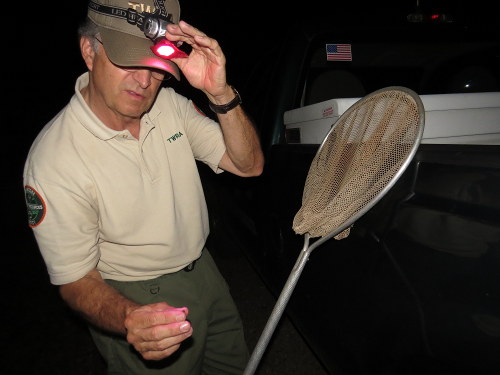
In the foreground: Predatory Photuris sp. which is recognizable by the red on the pronotum (head shield), larger size, and stripes on the wings. The firefly in the background is the Photuris frontalis (a.k.a. snappy sync). (Photo by TWRA)
By Tennessee Wildlife Resources Agency
Paul Shaw, a TWRA fisheries creel agent, has taken an interest in fireflies this summer, which has led to an amazing discovery.
Intrigued by the synchronous fireflies at Elkmont in the Great Smoky Mountains National Park and learning that Lynn Faust, the premiere synchronous firefly researcher in the GSMNP had them on her property near his own, Shaw set out on a mission to find other populations in east Tennessee.
His initial search in early June produced a healthy but isolated population on his densely forested property, which lies about a mile north of the Oak Ridge Wildlife Management Area.
During the next few weeks, Shaw—along with ORWMA Manager Jim Evans, former TWRA employee Wade Gefellars, and several others—formed a group called the “Firefly Team” that began visiting sites around ORWMA with hopes of discovering other synchronous fireflies. Their research areas consisted of about 30 sites, which were not arbitrary, random locations but were carefully calculated by biological factors similar to those at Elkmont.
To say that their research has been successful is an understatement. All of their predicted sites except one produced a species of synchronous fireflies called Snappy Syncs (Photuris frontalis), which are a different species than those in the GSMNP simply known as synchronous fireflies (Photinus carolinus). While not as well known to the general public as synchronous fireflies (Photinus carolinus), Snappy Syncs (Photuris frontalis) are not entirely unknown to firefly researchers, and have been found in various locations throughout the southeastern United States.
To help explain the difference between the two species, Shaw described their characteristic blink patterns. Synchronous fireflies (Photinus carolinus) blink about a half dozen times in synchrony, and then stop for a few seconds before starting again. Snappy Syncs (Photuris frontalis) blink about 30-plus times in synchrony with the rest in the group, then most will quit blinking while a few continue. After about 10 to 20 seconds, those that quit blinking will start again rejoining those that kept blinking.
“I have seen hundreds blinking perfectly together in this intermittent synchrony,” Shaw said. “The males are the ones (that) blink while the females are on the ground, blinking their own pattern to let the males know where they are.”
The highest blink rate the Firefly Team recorded was 114 blinks per minute at a temperature of 75 degrees.
For the Firefly Team, one great thing about Snappy Syncs is that they are possible to find outside of the GSMNP in the right habitat. Unlike that of Photinus carolinus, which has an altitude preference, the desired habitat of Snappy Syncs is not limited by lower elevations, making them more available to habitats in the southeastern U.S. and to seekers who care to explore and find them.
Photuris frontalis may be more widespread in east Tennessee than anyone has known, and further exploration may prove this to be true.
“That is the exciting thing about this species,” Shaw said. “By paying attention to their surroundings, the public may be able to discover pockets of them and see a tremendously entertaining light show without the limitations of the national park and its crowds. The synchronous pattern of this species is, to me, better than that I have seen by Photinus carolinus in the national park, and you don’t have to endure the crowds to see it.”
Shaw’s research has led him to believe ORWMA supports Snappy Syncs because it has remained relatively undisturbed since World War II. Similar to the GSMNP, preservation of the woodlands allowed them to mature into old-growth hardwood forests that are deep and dark at night. According to their research, 90 percent of the synchronous fireflies they discovered were in these deep, dark woods near a water source.
Shaw said that next year’s efforts will include further exploration of the 35,000 acre Oak Ridge Reservation/WMAÂ and that the Firefly Team will try to locate other populations of these interesting beetles.
This discovery is huge in the insect world as the population in the GSMNP was once thought to be the only place where you can see synchronous fireflies in North America, although it remains the best known. In 2012, a colony of these fireflies was also found in the Allegheny National Forest in Pennsylvania, another in the Congaree National Park in South Carolina, and in the mangrove forests of Southeast Asia.
While more research and density counts will be necessary in the future, there’s no doubt that this will be big news as the Elkmont population draws thousands of annual visitors to the GSMNP. However, the Oak Ridge Reservation is very secure, making it inaccessible to the public, thus prohibiting the multitudes of firefly seekers. At any rate, the fact that other synchronous firefly populations exist is encouraging making it possible for other firefly seekers to discover other populations.

TWRA Creel Agent Paul Shaw inspects a firefly as part of a research project on a species of synchronous firefly found in the Oak Ridge WMA this summer. (Photo by TWRA)
Copyright 2015 Oak Ridge Today. All rights reserved. This material may not be published, broadcast, rewritten, or redistributed.
Susan Gawarecki says
I’ve seen synchronized fireflies in the north Georgia mountains near Rich Mountain Wilderness.
johnhuotari says
Thank you for the additional info, Susan. I’m not sure I’ve ever seen synchronized fireflies. Someday I’ll have to make the trip up to GSMNP to see them there, or possibly to one of these other sites.